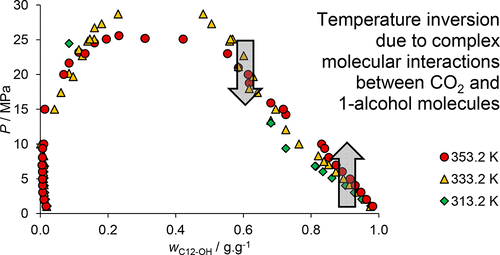当前位置:
X-MOL 学术
›
J. Chem. Eng. Data
›
论文详情
Our official English website, www.x-mol.net, welcomes your feedback! (Note: you will need to create a separate account there.)
High Pressure Phase Behavior of the Homologous Series CO2 + 1-Alcohols
Journal of Chemical & Engineering Data ( IF 2.6 ) Pub Date : 2018-03-15 , DOI: 10.1021/acs.jced.7b01000 Cara E. Schwarz 1
Journal of Chemical & Engineering Data ( IF 2.6 ) Pub Date : 2018-03-15 , DOI: 10.1021/acs.jced.7b01000 Cara E. Schwarz 1
Affiliation

|
The phase behavior of the supercritical CO2 + 1-alcohol homologous series for 1-octanol and higher alcohols is investigated. A literature survey revealed that sufficient data are available lower alcohols (1-decanol and lower) but data are limited for higher 1-alcohols. Data for CO2 + 1-dodecanol, CO2 + 1-tetradecanol, and CO2+1-hexadecanol were thus measured using a visual static synthetic method for T = 313–353 K. Measured and literature data indicated that the phase transition pressures are very high (>28 MPa) for CO2 + 1-decanol and higher alcohols in the mixture critical region. Additionally, a temperature inversion (increasing temperature leading to decreasing phase transition pressure) is present in the mixture critical region and is more pronounced in systems containing higher 1-alcohols. The temperature inversion is postulated to result from the formation of alcohol multimers due to hydrogen bonding between alcohol molecules. From the phase behavior data as well as published upper critical end point and solid–liquid–liquid–vapor equilibria data, Type III phase behavior according to the classification of Scott and van Konynenburg is assigned to the systems CO2 + 1-octanol to CO2 + 1-tetradecanol. However, for higher alcohols additional investigations are required to assign a phase behavior type. This systematic study hopes to aid future thermodynamic modeling attempts to describe the complex phase behavior of CO2 + 1-alcohol systems.
中文翻译:

同源系列CO 2 +1-醇的高压相行为
研究了1-辛醇和高级醇的超临界CO 2 + 1-醇同源系列的相行为。一项文献调查表明,有足够的数据可用于低级醇(1-癸醇及更低的醇),但对于高级1醇的数据是有限的。因此,使用视觉静态合成方法(T = 313–353 K)测量了CO 2 +1-十二烷醇,CO 2 +1-十四烷醇和CO 2 +1-十六烷醇的数据。实测值和文献数据表明,相变压力的CO 2很高(> 28 MPa)混合物关键区域中的+ 1-癸醇和高级醇。另外,在混合物临界区中存在温度反转(温度升高导致相转变压力降低),并且在含有较高的1-醇的体系中更为明显。推测温度反转是由于醇分子之间的氢键形成醇多聚体而引起的。根据相行为数据以及已发布的上限临界点和固-液-液-汽平衡数据,根据Scott和van Konynenburg的分类将III类相行为分配给系统CO 2 + 1-辛醇至CO 2个+ 1-十四烷醇。但是,对于高级醇,还需要进行其他研究才能确定相行为类型。这项系统的研究希望有助于将来进行热力学建模的尝试,以描述CO 2 +1-醇系统的复杂相行为。
更新日期:2018-06-03
中文翻译:

同源系列CO 2 +1-醇的高压相行为
研究了1-辛醇和高级醇的超临界CO 2 + 1-醇同源系列的相行为。一项文献调查表明,有足够的数据可用于低级醇(1-癸醇及更低的醇),但对于高级1醇的数据是有限的。因此,使用视觉静态合成方法(T = 313–353 K)测量了CO 2 +1-十二烷醇,CO 2 +1-十四烷醇和CO 2 +1-十六烷醇的数据。实测值和文献数据表明,相变压力的CO 2很高(> 28 MPa)混合物关键区域中的+ 1-癸醇和高级醇。另外,在混合物临界区中存在温度反转(温度升高导致相转变压力降低),并且在含有较高的1-醇的体系中更为明显。推测温度反转是由于醇分子之间的氢键形成醇多聚体而引起的。根据相行为数据以及已发布的上限临界点和固-液-液-汽平衡数据,根据Scott和van Konynenburg的分类将III类相行为分配给系统CO 2 + 1-辛醇至CO 2个+ 1-十四烷醇。但是,对于高级醇,还需要进行其他研究才能确定相行为类型。这项系统的研究希望有助于将来进行热力学建模的尝试,以描述CO 2 +1-醇系统的复杂相行为。


























 京公网安备 11010802027423号
京公网安备 11010802027423号